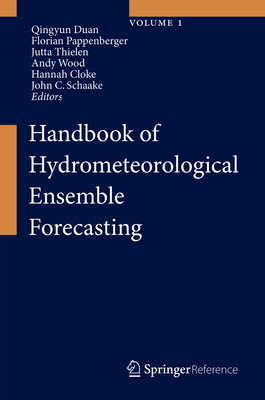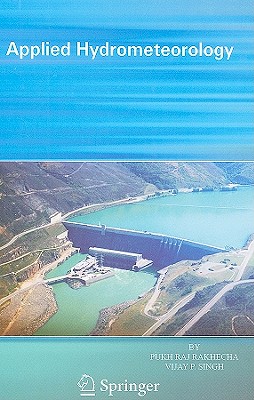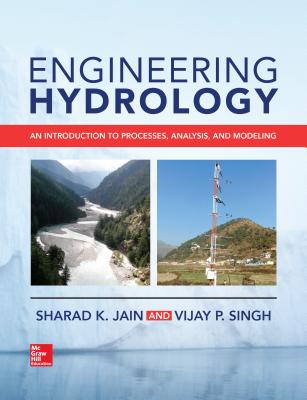Handbook of Hydrometeorological Ensemble Forecasting
暫譯: 水文氣象集合預報手冊
Duan, Qingyun, Pappenberger, Florian, Wood, Andy
- 出版商: Springer
- 出版日期: 2019-02-23
- 售價: $31,080
- 貴賓價: 9.5 折 $29,526
- 語言: 英文
- 頁數: 1528
- 裝訂: Hardcover - also called cloth, retail trade, or trade
- ISBN: 3642399266
- ISBN-13: 9783642399268
海外代購書籍(需單獨結帳)
相關主題
商品描述
Hydrometeorological prediction involves the forecasting of the state and variation of hydrometeorological elements -- including precipitation, temperature, humidity, soil moisture, river discharge, groundwater, etc.-- at different space and time scales. Such forecasts form an important scientific basis for informing public of natural hazards such as cyclones, heat waves, frosts, droughts and floods. Traditionally, and at most currently operational centers, hydrometeorological forecasts are deterministic, "single-valued" outlooks: i.e., the weather and hydrological models provide a single best guess of the magnitude and timing of the impending events. These forecasts suffer the obvious drawback of lacking uncertainty information that would help decision-makers assess the risks of forecast use. Recently, hydrometeorological ensemble forecast approaches have begun to be developed and used by operational hydrometeorological services. In contrast to deterministic forecasts, ensemble forecasts are a multiple forecasts of the same events. The ensemble forecasts are generated by perturbing uncertain factors such as model forcings, initial conditions, and/or model physics. Ensemble techniques are attractive because they not only offer an estimate of the most probable future state of the hydrometeorological system, but also quantify the predictive uncertainty of a catastrophic hydrometeorological event occurring. The Hydrological Ensemble Prediction Experiment (HEPEX), initiated in 2004, has signaled a new era of collaboration toward the development of hydrometeorological ensemble forecasts. By bringing meteorologists, hydrologists and hydrometeorological forecast users together, HEPEX aims to improve operational hydrometeorological forecast approaches to a standard that can be used with confidence by emergencies and water resources managers. HEPEX advocates a hydrometeorological ensemble prediction system (HEPS) framework that consists of several basic building blocks. These components include: (a) an approach (typically statistical) for addressing uncertainty in meteorological inputs and generating statistically consistent space/time meteorological inputs for hydrological applications; (b) a land data assimilation approach for leveraging observation to reduce uncertainties in the initial and boundary conditions of the hydrological system; (c) approaches that address uncertainty in model parameters (also called 'calibration'); (d) a hydrologic model or other approach for converting meteorological inputs into hydrological outputs; and finally (e) approaches for characterizing hydrological model output uncertainty. Also integral to HEPS is a verification system that can be used to evaluate the performance of all of its components. HEPS frameworks are being increasingly adopted by operational hydrometeorological agencies around the world to support risk management related to flash flooding, river and coastal flooding, drought, and water management. Real benefits of ensemble forecasts have been demonstrated in water emergence management decision making, optimization of reservoir operation, and other applications.
商品描述(中文翻譯)
水文氣象預測涉及對水文氣象要素的狀態和變化進行預測,包括降水、溫度、濕度、土壤濕度、河流流量、地下水等,這些預測在不同的空間和時間尺度上進行。這些預測為公眾提供有關自然災害(如氣旋、熱浪、霜凍、乾旱和洪水)的重要科學依據。傳統上,在大多數目前運行的中心,水文氣象預測是確定性的「單一值」展望:即氣象和水文模型提供即將發生事件的大小和時間的單一最佳猜測。這些預測明顯的缺點是缺乏不確定性信息,這將幫助決策者評估預測使用的風險。最近,水文氣象集合預測方法開始被開發並被運用於運行中的水文氣象服務。與確定性預測相比,集合預測是對同一事件的多重預測。集合預測是通過擾動不確定因素(如模型強迫、初始條件和/或模型物理)來生成的。集合技術具有吸引力,因為它們不僅提供水文氣象系統最可能的未來狀態的估計,還量化了災難性水文氣象事件發生的預測不確定性。水文集合預測實驗(HEPEX)於2004年啟動,標誌著水文氣象集合預測發展的新合作時代。HEPEX旨在將氣象學家、水文學家和水文氣象預測使用者聚集在一起,以改善運行中的水文氣象預測方法,使其達到可以讓緊急情況和水資源管理者自信使用的標準。HEPEX提倡一個水文氣象集合預測系統(HEPS)框架,該框架由幾個基本組件組成。這些組件包括:(a)一種方法(通常是統計方法)來處理氣象輸入的不確定性,並為水文應用生成統計一致的空間/時間氣象輸入;(b)一種土地數據同化方法,用於利用觀測數據減少水文系統初始和邊界條件的不確定性;(c)處理模型參數不確定性的方法(也稱為「校準」);(d)一個水文模型或其他方法,用於將氣象輸入轉換為水文輸出;最後,(e)用於表徵水文模型輸出不確定性的方法。HEPS的核心還包括一個驗證系統,可用於評估其所有組件的性能。HEPS框架正被全球越來越多的運行水文氣象機構採用,以支持與突發洪水、河流和沿海洪水、乾旱和水資源管理相關的風險管理。集合預測在水資源緊急管理決策、優化水庫運行和其他應用中已顯示出實際的好處。
作者簡介
Qingyun Duan (EIC): National Chair Professor and Chief Scientist of Faculty of Geographical Science at Beijing Normal University, author of >120 peer reviewed scientific papers. He is currently on editorial boards of several scientific journals and was the lead editor of the American Geophysical Union Water Science and Applications Monograph series "Calibration of Watershed Models." He is a Fellow of American Geophysical Union and American Meteorological Society.
Florian Pappenberger (Co-EIC): Director of Forecasts at the European Centre For Medium-Range Weather Forecasts. The Forecast Department at ECMWF has a strong user focus and undertakes production of forecasts, forecast evaluation and diagnostics, development of forecast products and applications, software development, catalogue and data services and outreach and training. Florian has a scientific background in the forecasting of weather driven natural hazards including floods, droughts, windstorms, forest fires and impacts on human health. He has over 10 years of expertise in operational probabilistic forecasting, extreme value statistics and numerical model system development at ECMWF. He was responsible for the development and implementation of the operational centre of the Copernicus Emergency Service - Early Warning Systems (floods). Florian is the author of over 150 publications, has won several scientific awards and is visiting Professor at the University of Bristol. He is an elected fellow of the Royal Geographical Society and the Royal Meteorological Society and a member of several other professional bodies including HEPEX, British Hydrological Society, EGU, AGU, EMS, AMS. He is on the editorial board of several international scientific journals and regularly advises on international committees including WMO.
Andy Wood (Co-EIC) a Development and Operations Hydrologist for the U.S. National Weather Service, Dr. Wood is also the Chair of the Hydrology Committee of the American Meteorological Society (AMS), an associate editor of the AMS Journal of Hydrometeorology, and a co-leader of the Hydrologic Ensemble Prediction Experiment (HEPEX). He previously worked as a research professor at the University of Washington Department of Civil and Environmental Engineering, and as the lead Scientist of a private renewable energy prediction firm, and has co-authored over 40 scientific publications focusing on hydrologic prediction, downscaling and climate change impact assessment, drought and other topics.
Hannah L. Cloke (co-EIC): a hydrologist and physical geographer specializing in land surface modeling, flood forecasting, applications of Numerical Weather Predictions and catchment hydrology. Her current research focuses on the theoretical and practical development of early warning systems for natural hazards, particularly for floods and droughts and disaster risk management.
Hannah is Visiting Professor in the Department of Earth Sciences at Uppsala University, Sweden. She is an elected fellow of the Royal Geographical Society and the Royal Meteorological Society. She works closely with the Environment Agency, the European Centre for Medium-Range Weather Forecasts (ECMWF) and the UK Met Office, as well as a wide range of other national and international partners. Hannah advises government on national and international flooding incidents and provides expert commentary in the media. She is Executive editor of Hydrology and Earth System Sciences and an active member of the HEPEX initiative.
John Schaake (co-EIC): formerly Chief Scientist with Office of Hydrologic Development, NOAA National Weather Service. He retired from National Weather Service after over 20 years of service in 2001. In retirement, he initiated the Hydrologic Ensemble Prediction Experiment (HEPEX) in 2004 and served as the inaugural co-chair for HEPEX scientific steering committee. Dr. Schaake is an internationally recognized expert on hydrometeorological ensemble forecasting and published extensively on hydrometeorological ensemble forecasting. Prior to his service in NOAA, he was an Associate Professor at Massachusetts Institute of Technology and University of Florida. He has served on editorial boards of various hydrology and water resources journals and various leadership posts of international organizations. He has been elected a Fellow of American Geophysical Union and American Meteorological Society.
作者簡介(中文翻譯)
**段青雲** (主編):北京師範大學地理科學學院的國家講座教授及首席科學家,發表超過120篇經過同行評審的科學論文。目前擔任多本科學期刊的編輯委員會成員,並曾擔任美國地球物理聯合會《水科學與應用專著系列》的主編,該系列專著名為《流域模型的校準》。他是美國地球物理聯合會及美國氣象學會的會士。
**弗洛里安·帕彭伯格** (共同主編):歐洲中期天氣預報中心的預報部門主任。ECMWF的預報部門以用戶為中心,負責預報的產出、評估和診斷、預報產品和應用的開發、軟體開發、目錄和數據服務以及外展和培訓。弗洛里安在預測由天氣驅動的自然災害(包括洪水、乾旱、風暴、森林火災及其對人類健康的影響)方面擁有科學背景。他在ECMWF擁有超過10年的運營概率預測、極值統計和數值模型系統開發的專業經驗。他負責開發和實施哥白尼緊急服務的運營中心——早期預警系統(洪水)。弗洛里安是超過150篇出版物的作者,獲得多項科學獎項,並擔任布里斯托大學的訪問教授。他是英國皇家地理學會和皇家氣象學會的當選會士,並且是HEPEX、英國水文學會、EGU、AGU、EMS、AMS等多個專業機構的成員。他擔任多本國際科學期刊的編輯委員會成員,並定期在包括WMO在內的國際委員會上提供建議。
**安迪·伍德** (共同主編):美國國家氣象局的發展與運營水文學家,伍德博士同時也是美國氣象學會(AMS)水文委員會的主席,AMS《水文氣象學期刊》的副編輯,以及水文集合預測實驗(HEPEX)的共同領導者。他曾在華盛頓大學土木與環境工程系擔任研究教授,並擔任一家私人可再生能源預測公司的首席科學家,並共同撰寫了超過40篇專注於水文預測、降尺度和氣候變化影響評估、乾旱等主題的科學出版物。
**漢娜·L·克洛克** (共同主編):專注於地表建模、洪水預測、數值天氣預報應用及流域水文的水文學家和物理地理學家。她目前的研究重點是自然災害早期預警系統的理論和實踐開發,特別是針對洪水和乾旱及災害風險管理。
漢娜是瑞典烏普薩拉大學地球科學系的訪問教授。她是英國皇家地理學會和皇家氣象學會的當選會士。她與環境署、歐洲中期天氣預報中心(ECMWF)及英國氣象局密切合作,並與多個國內外夥伴合作。漢娜為政府提供有關國內和國際洪水事件的建議,並在媒體中提供專家評論。她是《水文與地球系統科學》的執行編輯,並積極參與HEPEX倡議。
**約翰·沙克** (共同主編):曾任美國國家海洋和大氣管理局(NOAA)國家氣象局水文發展辦公室的首席科學家。他在2001年退休,並在退休後於2004年啟動了水文集合預測實驗(HEPEX),並擔任HEPEX科學指導委員會的首任共同主席。沙克博士是國際公認的水文氣象集合預測專家,並在水文氣象集合預測方面發表了大量文獻。在加入NOAA之前,他曾擔任麻省理工學院和佛羅里達大學的副教授。他曾在多個水文和水資源期刊的編輯委員會及國際組織的各種領導職位上任職。他被選為美國地球物理聯合會和美國氣象學會的會士。































